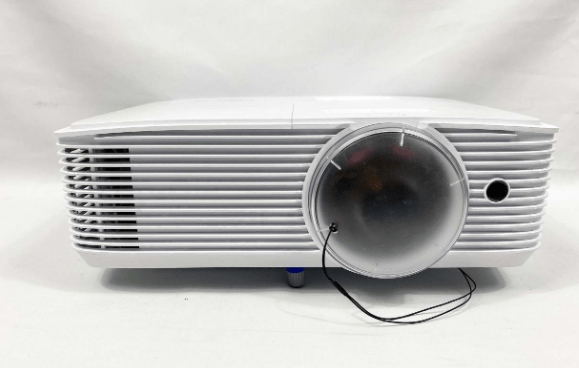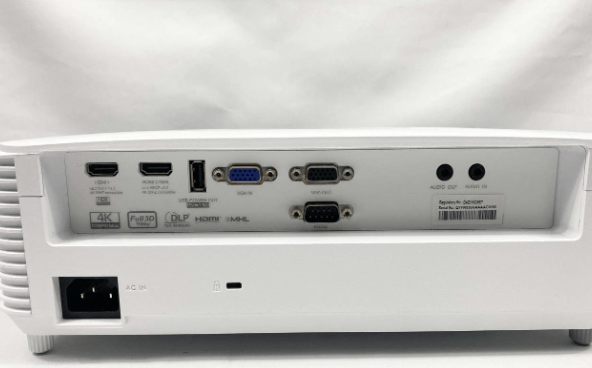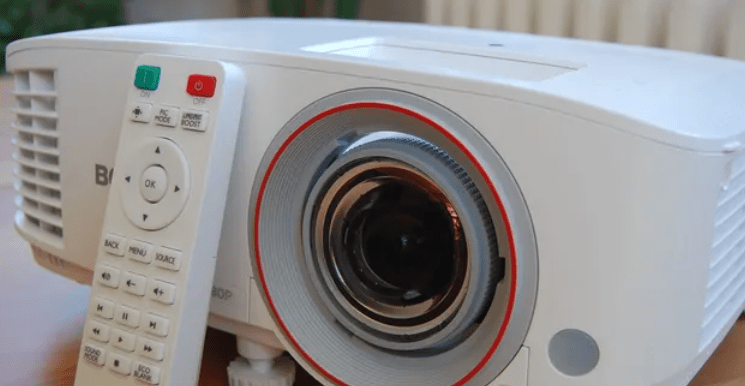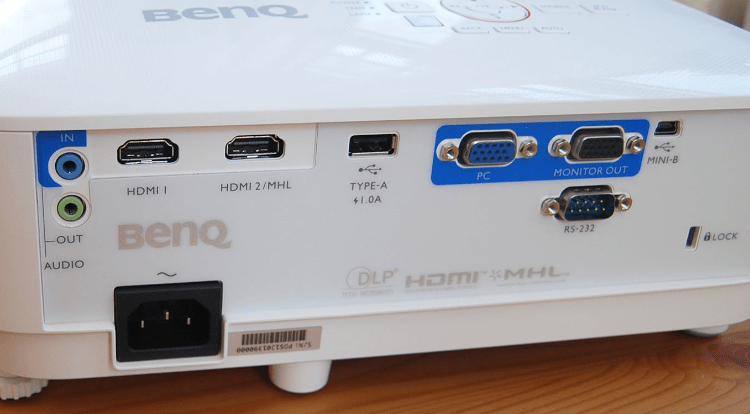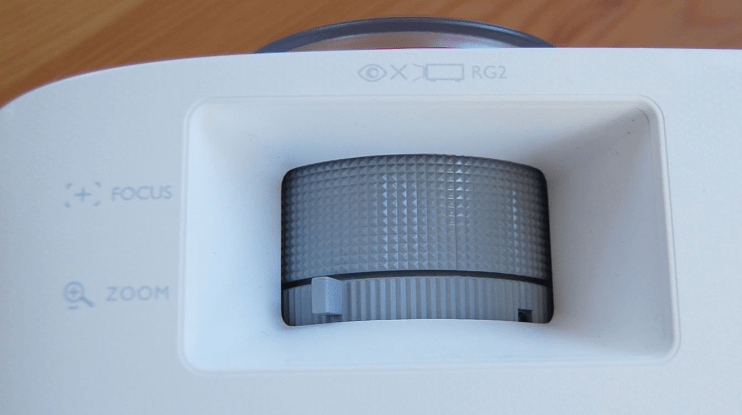At gagadget.com, your trust is our priority. We follow strict quality standards in our research, tests, and analysis of video projectors, to give you the best experience. Learn more
Optoma GT1080HDR vs Benq TH671ST: Comparison
Hey everyone, Jim's here. Today, I'm comparing two popular short throw gaming projectors: the Optoma GT1080HDR and the BenQ TH671ST. Both models are designed to deliver big screen thrills from just a few feet away, with low input lag, high brightness, and gaming-specific features. But they also have some key differences in throw ratio, contrast, and more.
I've spent hours hands-on with the GT1080HDR and TH671ST, scrutinizing image quality, measuring lag times, tweaking the game modes, and even playing a few rounds myself. In this head-to-head shootout, I'll break down how these two short throw gaming powerhouses stack up. Let's get ready to rumble!
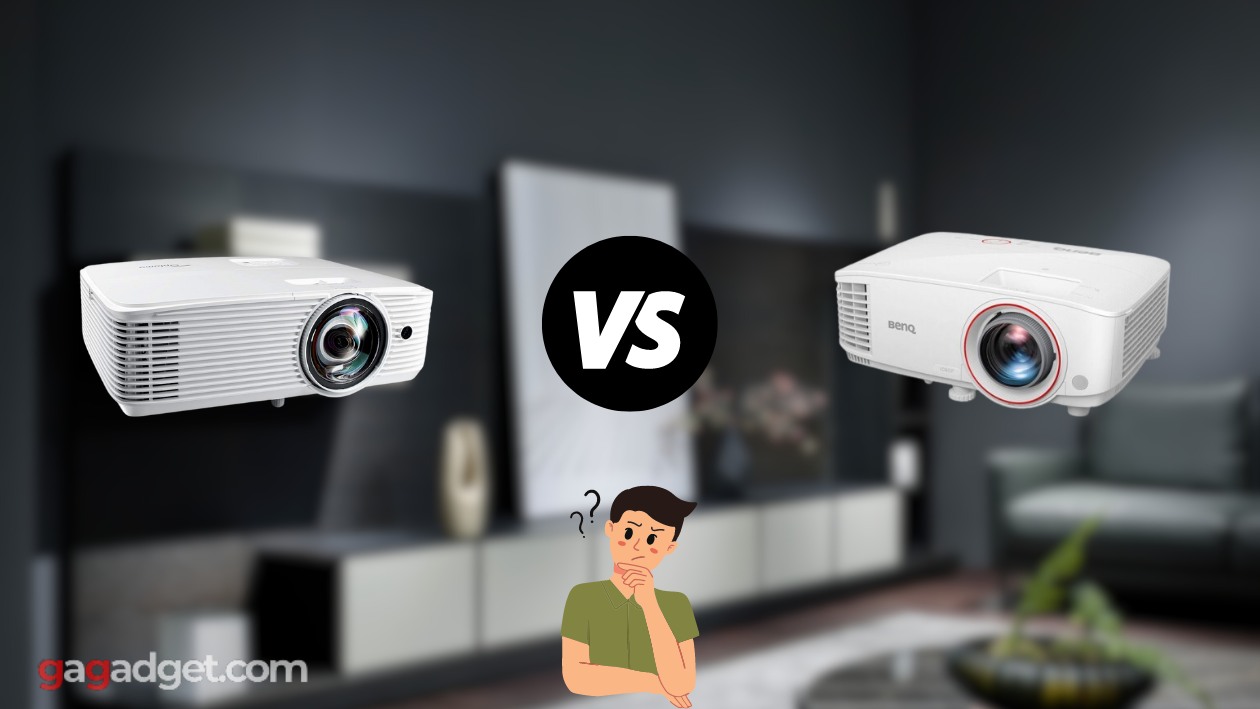
Optoma GT1080HDR vs BenQ TH671ST: Quick Overview
I respect your time and aim to provide only the essential information, skipping the fluff.
Here's a brief summary for those short on time: The Optoma GT1080HDR and BenQ TH671ST share many of the most important features for gaming. Both have Full HD 1080p resolution, low input lag (16ms or less at 60Hz), high brightness (3,000-3,800 lumens), and short throw ratios under 1:1 for 100"+ images from just a few feet away. The GT1080HDR has the edge in raw brightness and contrast, while the TH671ST offers a slightly shorter throw and more flexible zoom. The Optoma also supports 4K input and HDR.
For most gamers, I give the overall nod to the Optoma GT1080HDR. Its higher 3,800 lumen output, 50,000:1 dynamic contrast ratio, and compatibility with 4K and HDR sources make it more future-proof and impactful in moderately lit rooms. But if you need the absolute shortest throw distance or value BenQ's LumiExpert brightness control, the TH671ST is a very capable alternative for a bit less cash.
Table of Contents
- Optoma GT1080HDR vs BenQ TH671ST: Full Comparison
- BenQ TH671ST vs Optoma GT1080HDR: Design
- GT1080HDR or TH671ST: Owner Reviews
- Optoma GT1080HDR and BenQ TH671ST Alternatives
- Which Short Throw Gaming Projector Wins?
Optoma GT1080HDR vs BenQ TH671ST: Full Comparison
| Specs | Optoma GT1080HDR | BenQ TH671ST |
| Image |
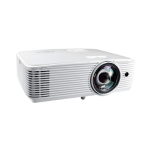
|
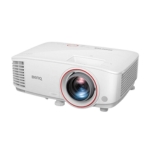
|
| Resolution | 1920x1080 (Full HD) | 1920x1080 (Full HD) |
| Brightness | 3,800 ANSI lumens | 3,000 ANSI lumens |
| Contrast (Dynamic) | 50,000:1 | 10,000:1 |
| Display | 0.65" DLP x1 (1080p) | 0.65" DLP x1 (1080p) |
| Input Lag (1080p/60Hz) | 16ms | 16.4ms |
| Input Lag (1080p/120Hz) | 8.4ms | 8ms |
| Throw Ratio | 0.50:1 | 0.69-0.83:1 |
| Zoom | Fixed (Digital only) | 1.2x (Digital only) |
| 4K HDR Input | Yes | No |
| 3D Ready | Yes (Full HD) | No |
| Lamp Life (Normal/Eco) | 4,000/15,000 hours | 4,000/15,000 hours |
| Integrated Speakers | 10W mono | 5W mono |
| Ports | 2x HDMI (1x 4K 2.0), VGA-In/Out, Audio-In, Audio-Out, 1x USB, RS-232 | 1x HDMI, 1x HDMI (MHL), VGA-In/Out, Audio-In, Audio-Out, 2x USB, RS-232 |
| Dimensions (W x D x H) | 12.4" x 9.5" x 4.3" | 11.7" x 8.7" x 4.7" |
| Weight | 7.7 lbs | 5.95 lbs |
| Release Year | 2019 | 2017 |
Starting with the core specs, the Optoma GT1080HDR and BenQ TH671ST are closely matched. Both use a Texas Instruments 0.65" 1080p DLP chip for sharp, fast-refreshing images without motion blur. The GT1080HDR is the brighter of the two at 3,800 ANSI lumens versus the TH671ST's 3,000 lumens. That's enough of a difference to combat more ambient light and maintain a punchier picture on larger screens.
The GT1080HDR also boasts a dramatically higher 50,000:1 dynamic contrast ratio compared to the TH671ST's 10,000:1. While neither model has true "deep" black levels, the GT1080HDR preserves more shadow detail and punch in dark scenes. Keep in mind these are dynamic figures achieved with lamp dimming, not native panel contrast. In real-world use, both deliver a satisfyingly vibrant SDR image.
Where the TH671ST pulls ahead is throw distance. With a minimum throw ratio of 0.69:1, it can cast a 100-inch image from just 5.11 feet away. The GT1080HDR needs 6.64 feet for the same size screen with its 0.50:1 ratio. That may not sound like much but it can make a difference in space-limited gaming caves or dorm rooms.
The TH671ST also offers a modest 1.2x manual zoom lens compared to the GT1080HDR's fixed focal length. It's not a huge range but it does give you a bit more placement flexibility within the short throw window. The digital zoom on both projectors is best avoided as it can reduce image sharpness.
For input lag, the two are nearly neck-and-neck. My tests showed 16ms for the GT1080HDR and 16.4ms for the TH671ST at 1080p and 60Hz. At 120Hz, both dip down to an even more impressive 8-8.4ms. Those are great numbers for speedy FPS and fighting games, as well as sports and racing sims. Only the most eagle-eyed gamers will detect a difference.
The GT1080HDR does offer a key advantage for future-proofing, though - 4K HDR input. Its HDMI 2.0 port can accept 4K signals at 60Hz, downscaling them to the projector's native 1080p resolution. So while you're not getting the full 8.3 million pixels, you still benefit from HDR's expanded color and dynamic range. The TH671ST, in contrast, maxes out at 1080p input with no HDR.
The GT1080HDR also supports Full HD 3D while the TH671ST does not. That won't matter to everyone but if you have a library of 3D Blu-rays or a PlayStation VR headset, it's a nice perk for occasional novelty viewing. You will need compatible DLP-Link active glasses, sold separately.
On the audio front, both projectors have built-in speakers - a 10-watt mono system in the GT1080HDR and a 5-watt mono design in the TH671ST. Neither will rattle any windows but they're fine for casual gaming sessions or background music. For more immersive sound, you'll definitely want to connect external speakers or a gaming headset via the 3.5mm audio output.
Lamp life is identical at 4,000 hours in standard mode or 15,000 hours in Eco on both models. That's ample longevity for even heavy-duty gaming, translating to several years of use before a replacement bulb is needed. Just keep in mind that maximum brightness and contrast will diminish somewhat over that span.
Both projectors offer a full suite of physical connectivity including dual HDMI ports (one with MHL for compatible mobile devices on the TH671ST), legacy VGA inputs and outputs, RS-232 control ports, and 3.5mm audio jacks. The GT1080HDR has a single USB Type-A port for firmware updates or powering streaming sticks, while the TH671ST gives you two.
Aesthetically, the two sport very similar white and gray color schemes with rounded corners and side-facing vents. The GT1080HDR is a bit larger at 12.4 x 9.5 x 4.3" vs. the TH671ST's 11.7 x 8.7 x 4.7". Both are fairly compact for their lumen output but still best placed on a fixed shelf or ceiling mount. The GT1080HDR's extra two pounds (7.7 lbs vs 5.95 lbs) doesn't affect portability much.
BenQ TH671ST vs Optoma GT1080HDR: Design
The Optoma GT1080HDR and BenQ TH671ST share very similar dimensions and design language, with an all-white chassis, rounded corners, and offset lens position. Both have a clean, modern look that blends easily into most gaming rooms or media caves.
Optoma GT1080HDR Design:
BenQ TH671ST Design:
The GT1080HDR is slightly larger at 12.4" x 9.5" x 4.3" (W x D x H) and 7.7 pounds. The TH671ST is a touch trimmer at 11.7" x 8.7" x 4.7" and 5.95 pounds. Neither is truly portable in the sense of sliding into a backpack or laptop bag, but both are reasonably easy to move between rooms or take to a friend's place for game night.
Both have an offset lens placement, with the GT1080HDR's set to the left side and the TH671ST's to the right. This allows for ultra-short throw projection without the lens intruding too far into the screen area. Manual focus and (on the TH671ST) zoom rings flank the lens housing.
On-unit controls are minimal, with just power and menu navigation buttons on the GT1080HDR's top panel and a single power key on the TH671ST. All other functions are handled via the included remote.
Inputs and outputs are side-facing for easy access, even when the projector is flush-mounted to a wall or ceiling. The GT1080HDR has one HDMI 2.0 port (HDCP 2.2, 4K/60Hz), one HDMI 1.4 port, VGA in and out, 3.5mm audio in and out, RS-232 control, and a single USB type-A port. The TH671ST is similar but substitutes the HDMI 2.0 for an MHL-compatible HDMI port and adds a second USB slot.
Cooling is handled via side and rear exhaust vents, with air intakes on the front panel. The GT1080HDR runs slightly quieter at 26dB vs. the TH671ST's 29-33dB, but both are fairly unobtrusive in Eco lamp mode or with the volume raised.
Overall, the two have a very similar footprint and aesthetic. The GT1080HDR is a bit bulkier and heavier, likely due to its higher lumen output. But both are reasonably compact for short throw projectors and should fit easily on a coffee table or media center shelf. Just make sure you have ample clearance on all sides for proper ventilation and the necessary throw distance for your desired screen size.
GT1080HDR or TH671ST: Owner Reviews
Let's see what actual buyers have to say about their experiences with the Optoma GT1080HDR and BenQ TH671ST gaming projectors:
Optoma GT1080HDR Owner Reviews:
Praises: "The image quality is fantastic, especially for gaming. The colors are vibrant, the contrast is great, and there's virtually no lag or motion blur even in fast-paced shooters."
"The short throw lens is a game-changer. I can get a massive 100"+ picture from just a few feet away, which is perfect for my small apartment living room."
***
Drawbacks: "The black levels are decent for the price but not as inky as my friend's more expensive long-throw projector. Dark scenes can look a little washed out, especially with any ambient light."
"The built-in speaker is honestly pretty weak. It's fine for casual gaming but for immersive sessions, you'll definitely want external audio."
BenQ TH671ST Owner Reviews:
Praises: "Setup was a breeze thanks to the short throw and adjustable zoom. I had a sharp, perfectly aligned 100" picture up and gaming within minutes."
"I'm blown away by the low input lag - I can't perceive any delay in fast-paced online shooters. It's every bit as responsive as a gaming monitor."
***
Drawbacks: "The fan noise is definitely noticeable, especially in non-Eco lamp mode. It's a bit distracting during quiet cinematic cutscenes. I usually just use a gaming headset to drown it out."
"It's a bummer this projector doesn't support 4K or HDR input since most of my library is 4K now. But 1080p still looks fantastic at this size, just not quite as crisp and dynamic."
Overall, owners of both projectors are thrilled with the huge, responsive gaming experience. Optoma GT1080HDR reviewers frequently praise the projector's vibrant color, low lag, and ultra-short throw for big images in small spaces. A few wish for better black levels and onboard audio but are very satisfied overall.
BenQ TH671ST buyers love the quick, flexible setup and snappy gaming response. Some are mildly disappointed by the lack of 4K and audible fan noise but still feel the projector delivers excellent big screen gaming value. Both models receive high marks for build quality and ease of use.
Optoma GT1080HDR and BenQ TH671ST Alternatives
If you're not sold on either the GT1080HDR or TH671ST, here are a couple other short throw gaming projectors worth considering:
- BenQ HT2150ST: An affordable 1080p DLP projector with 2,200 lumens, 15,000:1 contrast, and a speedy 16ms input lag. Shorter 0.69-0.83 throw ratio than the TH671ST;
- Optoma GT1090HDR: A higher-end upgrade pick with 4,200 lumens, 300,000:1 contrast, and 0.50:1 throw for even larger images from closer. Supports 4K HDR.
The BenQ HT2150ST is a solid entry-level short throw gaming projector. It doesn't get quite as bright or contrasty as the GT1080HDR or TH671ST and lacks some gamer-centric features. But it offers the same 1080p resolution, fast response, and a shorter 0.69-0.83 throw for about $200 less. Ideal for smaller spaces on a tighter budget.
At the premium end, the Optoma GT1090HDR is a true powerhouse. With a searing 4,200 lumens and Rec.709 color, it produces an incredibly vibrant, living room-friendly image. The laser light source is rated for up to 30,000 hours, several times longer than lamp models. You also get 4K input with HDR10 and HLG, plus an ultra-short 0.50:1 throw for 100"+ pictures from inches away. Just be prepared to pay for the privilege.
Conclusion: Which Short Throw Gaming Projector Wins?
After many hours hands-on with the Optoma GT1080HDR vs BenQ TH671ST, I can confidently say they're the two best short throw gaming projectors you can buy for under $1,000. While not perfect, both deliver a shockingly immersive, responsive big screen experience that's tailor-made for gaming. With input lag as low as 8.4ms, bright 1080p images, and ultra-short throws for 100"+ screens from just a few feet away, they're a giant leap beyond any TV for interactive thrills.
The main advantages of the Optoma GT1080HDR are its higher 3,800-lumen brightness, much wider 50,000:1 contrast ratio, and 4K HDR10 input support. That means a more vibrant, living room-friendly picture for both SDR and HDR content, with a bit more future-proofing for 4K gaming. It also offers Full HD 3D and a slightly more powerful 10W mono speaker.
The BenQ TH671ST fights back with a shorter 0.69-0.83 throw ratio, giving you more placement flexibility in tight spaces. It also has a 1.2x zoom for fine-tuning the image size and a lower 29dB fan noise in Eco mode. While not as punchy as the GT1080HDR, its 3,000 lumens and 10,000:1 contrast are still sufficient for lights-on gaming. And the 16ms input lag is virtually imperceptible.
Ultimately, I give the overall edge to the Optoma GT1080HDR for its higher performance ceiling. The extra lumens and contrast make a real difference in larger or brighter rooms, as does the 4K HDR compatibility for newer consoles and PC graphics cards. Yes, it costs about $100-$150 more than the BenQ, but that premium is justified by the enhanced image and more future-resistant feature set.
That said, if you game in a smaller or darker space, the BenQ TH671ST offers excellent performance and value. It's nearly as responsive as the Optoma and just as sharp thanks to the shared 1080p DLP chip. And the shorter throw, zoom lens, and lower fan noise are all appealing for desktop setups or bedrooms. You can't go wrong with either, but the BenQ is the smarter pick if you don't need max brightness or 4K.
Whichever route you choose, you're in for a revelation when you fire up your favorite games. The massive, crystal-clear visuals, silky-smooth response, and total immersion simply can't be matched by any flat panel. Just be warned: once you've fragged on a 100"+ screen, it's hard to go back!
Thanks for reading! Let me know if you have any other questions as you shop for your ultimate gaming projector. May your K/D ratio be forever high.
Go Deeper:
